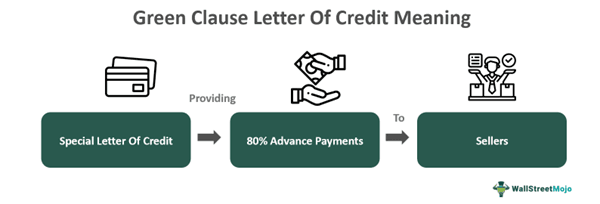Table of Contents
What Is A Green Clause Letter Of Credit?
A green clause letter of credit (LC) refers to a particular type of letter of credit that provides up to 80% of advance payments to the sellers. It acts as an enabler for buying raw materials, packaging products, processing, insurance expenses, and pre-shipment warehousing at the concerned port of origin.

Sellers use it as a tool of working capital management, whereas buyers get the opportunity to negotiate favorable trade terms through the offer of advance payment to the seller. The advanced amount plus fees and interest gets deducted from the existing credit. It finds extensive usage in the commodity sector.
Key Takeaways
- A green clause letter of credit (LC) provides a maximum of 80% advance payments to sellers, enabling raw material purchases, product packaging, and processing, insurance, and pre-shipment warehousing at the port of origin.
- Its process involves incorporating a green clause into an LC, amending it to cover extra costs, and liquidating the LC after delivery.
- It offers regular working capital to manufacturers & sellers but has a higher cost than regular LC for buyers.
- It enables up to 70-80% advance payment by the bank, whereas red clause LC enables only a small portion of advance up to 25%.
Green Clause Letter Of Credit Explained
A green clause letter of credit meaning is stated as a letter of credit offering reimbursement after a specific communication concerning warehousing. The clause is embossed or printed in green ink, separating it from the red clause letter of credit. Per the green clause LC, it acts as a financial instrument guaranteeing payments from buyers to sellers after the finished goods are stored in a particular warehouse related to the shipment port. Moreover, sellers can use green clause LC as a secured type of documentary loan after pledging the warehouse receipts.
Further, the buyer can instruct its banker to add a green clause LC to aid the seller. The green clause LC should contain identical terms & conditions written in the trade contract amongst the parties. Additionally, green clause LC needs goods delivery to a fixed warehouse prior to production of a public or bonded warehousing company. Such warehouses facilitate document issuance and confirmation of paperwork. All documentation proving the products are in warehousing is given to the bank that granted the LC.
After obtaining confirmation of storage and insurance coverage for the items, the bank distributes the funds received in advance to the recipient. Green clause LC has become more prevalent in commodity deals or when established trade partners offer commodities on a regular basis. Significant global trade agreements also demand the distribution of commodities in a succession of delivery packages using advance payments to be made in a series.
All payments need to be offset by the appropriate payment amounts and liquidated upon final delivery. Concisely, the green clause LC provides more financial security to buyers than any other documentary credit. It happens because the payments could be manipulated by offsetting the balances that remain. Moreover, buyers have the power to appoint a third-party manager as a warehouse facilitator to check on the timely progress of the goods.
The Hargreaves Lansdown provides access to a range of investment products and services for UK investors.
Process Steps
To initiate the process, both buyer and seller have to agree upon trading the goods between them. Then, as per the green clause letter of credit sample, its issuance process comprises multiple steps:
- Issuance of green clause LC starts with the buyer (consignee) approach to include the green clause in their LC for the seller or consignor, reflecting the trade agreement terms and conditions between the parties.
- Next, the amendment of LC takes place by adding coverage of the extra cost of insurance and pre-shipment warehousing. It helps the seller to manage the expenses related to packaging, transportation, and manufacturing.
- After the goods are successfully delivered to the buyer, the seller approaches their bank to receive the payment, and then the LC gets liquidated. After that, the bank subtracts interest and advance amounts to pay the seller what they owe from the buyer.
Examples
Let us use a few examples to understand the topic.
Example #1
Let us assume that a US-based company, Green Hydra, acts as a buyer and purchases goods worth $60,000 from UK-based Red Tech. Both parties agree to use the green clause LC for the trade payment. As a result, Green Hydra approaches its bank XYZ in the us to issue a green clause LC in favor of Red Tech. Hence, advising bank B of bank XYZ in the UK informs them of the same so they can start production. Red tech shows the necessary documents to bank B when the production has been completed and obtains 50% advance payments to make shipment possible.
As soon as the buyer receives the specific documents from their bank, they release the full and final payment to the seller, along with the service charges and interest for the advance. Finally, the letter of credit allows for a total settlement with security and structured trade, fostering trade and trust between the two companies involved.
Example #2
Let us assume that a company, Old York Limited of the United States, has to buy raw materials from India. Hence, it offers advance payment to the Indian company, providing it with the raw material through a green clause letter of credit. Old York Limited did it to help Indian manufacturers cover their production costs, warehousing costs, and interest until the raw materials are shipped.
As a result, the Indian company completes the raw material production and ships the same to the American company without any problem. Thus, the Su company gets the benefit of a secured transaction, favorable terms, negotiability, and a trusted relationship with the company. On the other hand, the Indian company gains financial independence and flexibility to fulfill orders without any cash restraints.
Advantages And Disadvantages
Since it plays a crucial role in international trade, its pros and cons must be clear to everyone, as per the table below:
| Advantages | Disadvantages |
|---|---|
| Offers regular working capital to manufacturers & sellers. | Has a higher cost than regular LC for buyers. |
| Help avoid downtime in the absence of raw materials for production. | Time-consuming new trade deals as the consignee has given more time to appoint a collateral supervisor. |
| On-port warehousing coverage reduces tension concerning pre-shipment goods warehousing trade deals. | They need more flexibility. |
| Enables long-term and long-distance relationships between exporters and importers | Advance amounts cannot be changed even if the seller requires more in later stages. |
| Importers use it to get favorable trade deals. | |
| It is safer than the red clause LC due to the involvement of collateral. |
Differences Between Green Clause And Red Clause Letter Of Credit
Both function as a way to get an advance payment to the seller; however, they have specific differences, as shown below:
| Green Clause Letter Of Credit | Red Clause Letter Of Credit |
|---|---|
| It enables up to 70-80% advance payment by the bank. | Enables only a small portion of advance up to 25%. |
| Importers have greater security over their goods. | Buyer takes advance prior to producing the goods, making it less secure. |
| Advance extended against the title document of gods already warehoused by the bank. | Advances have to be made even before the goods have been produced. |
| Advance can be transferred only by adding a document of title along with receipts and written undertakings by the bank. | Advances can be transferred using only written undertakings and receipts from the bank. |
| Documents required are additional title documents, written undertakings, and receipts. | Receipts and written undertakings are required here. |
| Manufacturers and sellers both have their working capital boosted. | Unsecured financing boosts the seller's working capital. |
| Sellers get collateral-based and secured loans. | Sellers get unsecured loans from buyers. |
Disclosure: This article contains affiliate links. If you sign up through these links, we may earn a small commission at no extra cost to you.

